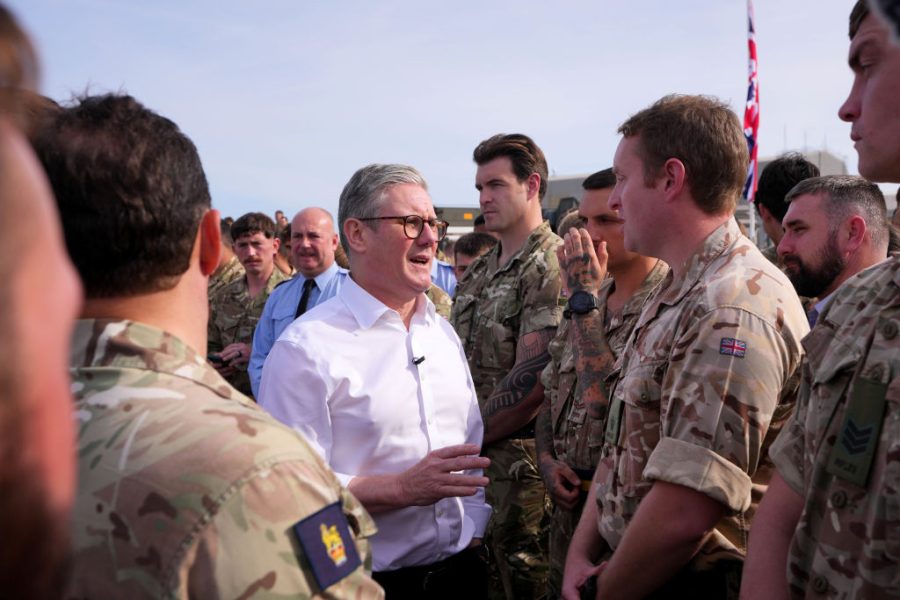Over the last few years, defence spending has been higher up the political agenda than at any time since the end of the Cold War. The scale, intensity and sheer cost of the war in Ukraine following Russia’s invasion in February 2022 provided a shock to the system – but it only reinforced what many of us had known for a long time: the United Kingdom’s military capabilities in every domain are underfunded, stretched beyond endurance and often non-functional. But is Keir Starmer now avoid increasing defence spending at all?
Last February, the House of Commons defence committee published a report entitled Ready for War?. It had damning conclusions. The armed forces ‘have capability shortfalls and stockpile shortages, and are losing personnel faster than they can recruit them… [and] are also consistently overstretched’. The following month, the Public Accounts Committee reported on the Ministry of Defence’s Equipment Plan 2023-2033. It found a staggering deficit of at least £16.9 billion between the capability requirements of the armed forces and the available budget. The true figure is almost certainly closer to £20 billion.
Currently we are asking the military to run a Formula 1 team on the budget of a weekend club racer
The shock at least had some effect. In April, the Conservative prime minister, Rishi Sunak, announced that he would increase defence spending to 2.5 per cent of GDP – around £87 billion a year – by 2030. In the run-up to the general election, Labour cast doubt on the government’s ability to deliver this increase, while nodding evasively towards it in its own manifesto. It promised a strategic defence review within a year of taking office, in the light of which it would ‘set out the path to spending 2.5 per cent of GDP on defence’.
This tortured phraseology rightly unsettled many observers. In July, I argued that the strategic defence review (SDR) was welcome but that it had to be accompanied by an increase in spending to at least 2.5 per cent of GDP. I have said again and again that for ministers to parrot this peculiar formulation of ‘setting out a path’ to additional spending negates it as a meaningful commitment. Without any kind of timeframe, except that it will ‘be dealt with at a future fiscal event’, to quote the SDR’s terms of reference, it is no promise at all, an empty aspiration.
There are now rumours that the target of 2.5 per cent will not be reached in this parliament, or even by 2030. The Times quoted an anonymous ‘senior government source’ as saying: ‘If we try to hit the target by 2030 it will mean deeper cuts to public services in the run-up to the election. It feels like a non-starter.’
This is a well-worn maxim: the electorate will not support more spending on defence if it has a negative effect on schools, hospitals and other public services they see every day. But if Sir Keir Starmer abandons the idea of hitting that arbitrary but symbolic level of 2.5 per cent for the rest of the decade, it will have catastrophic effects on national security.
Let us be clear about the situation. Even if a magic wand was waved and the Ministry of Defence had the additional resources to spend tomorrow, it would not be the beginning of a bonanza of procurement and largesse. Last year, the defence budget was 2.3 per cent of GDP, a total of around £55 billion. An additional 0.2 per cent is obviously welcome, but it will, at best, allow the armed forces to make good some of their current glaring capability gaps.
In short, 2.5 per cent might allow the Royal Navy, the Army and the Royal Air Force to carry out the tasks they are already expected to perform. It is a status quo increase, tacitly acknowledging that the glassy-eyed optimism of senior civilian and military staff is frighteningly detached from reality.
Realistically, however, even that higher level of spending is not nearly enough. The armed forces have reached an inflection point, and the government has a stark choice: either it must commit significantly more resources to personnel and equipment, or it must radically scale back its commitments, ambitions and strategic footprint. Currently we are asking the military to run a Formula 1 team on the budget of a weekend club racer. It is unsustainable.
I say ‘unsustainable’ in all seriousness. The Army depends on being able to deploy the 3rd (UK) Division as a war-fighting unit within a larger Nato force at very short notice. This is currently impossible. The Royal Navy has five attack submarines, of which at least three cannot put to sea because they are awaiting maintenance and repair. None of the three services are at full strength. The military is not currently fit for purpose.
The government cannot look away and hope for the best. There must be more money or fewer commitments – a third option does not exist. The Prime Minister likes to talk about taking ‘tough decisions’, and this is the toughest. If he knows now that the target of 2.5 per cent will not be reached by 2030, he must say so and make policy changes accordingly. Anything else is a reckless betrayal of our national security.








Comments